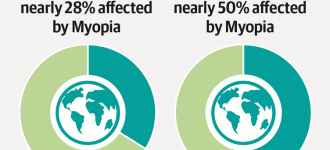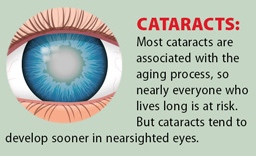 Myopia, also known as near-sightedness, is the most common refractive error of the eye and it has become more prevalent in recent years. Studies have shown in 2010, approximately 28% of the world was myopic and an estimated for 2050 has increased to 50% myopes.
Myopia, also known as near-sightedness, is the most common refractive error of the eye and it has become more prevalent in recent years. Studies have shown in 2010, approximately 28% of the world was myopic and an estimated for 2050 has increased to 50% myopes.
 Myopia is defined as light focuses in front of the retina. This results in blurry vision that is worse for distance objects as compared to near objects. Myopia results when the length of the eyeball also known as the axial length of the eye (measured from the front of the cornea to the back of the retina) is elongated. The higher the degree of myopia, the greater the distance vision blur and the closer the point of clear focus becomes for the individual.
Myopia is defined as light focuses in front of the retina. This results in blurry vision that is worse for distance objects as compared to near objects. Myopia results when the length of the eyeball also known as the axial length of the eye (measured from the front of the cornea to the back of the retina) is elongated. The higher the degree of myopia, the greater the distance vision blur and the closer the point of clear focus becomes for the individual.
Why is my child nearsighted?
 Genetics play a role. If both parents are myopic, there is a higher risk of the children having myopia. Research has shown that children who spend more time outdoors are at lower risk for childhood myopia. Children who spend a lot of time engaged in near tasks (reading, computers, hand-held electronics) have a higher risk of becoming myopic.
Genetics play a role. If both parents are myopic, there is a higher risk of the children having myopia. Research has shown that children who spend more time outdoors are at lower risk for childhood myopia. Children who spend a lot of time engaged in near tasks (reading, computers, hand-held electronics) have a higher risk of becoming myopic.
With the progression of myopia, there is an increased risk of complications in the eyes. These include but are not limited to cataracts, glaucoma, myopic maculopathy, retinal hole, retinal tear and retinal detachment.



